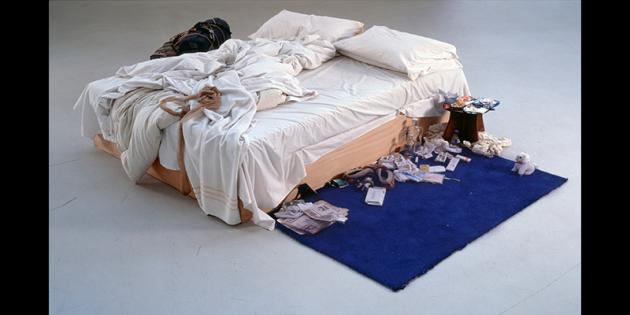Tracey Emin’s Turner prize nominated ‘My Bed’, which recently sold at Christie’s for £2.5m, a record for the artist, will return to the UK after a long-term loan to Tate is finalised. Full details will be announced in the autumn.
Count Duerckheim the new owner of the installation said: ‘I always admired the honesty of Tracey, but I bought My Bed because it is a metaphor for life, where troubles begin and logics die.’ Nicholas Serota, Director, Tate said: ‘I am absolutely delighted that Count Duerckheim has agreed to loan such an important work to Tate for a period of at least ten years. We look forward to displaying the work and are most grateful to Count Duerckheim for his generosity in creating an opportunity for visitors to see a work that now has iconic status.’
One of Britain’s most celebrated works of modern art, My Bed was made in Tracey Emin’s Waterloo council flat in 1998. It was purchased by Charles Saatchi who recently sold the sculpture to raise funds for his gallery. Referred to by the artist as an unconventional and uncompromising self-portrait through objects, it features the artist’s own bed covered in stained sheets, discarded condoms, blood-stained underwear and empty bottles of alcohol. The piece gives a snapshot of the artist’s life after a traumatic relationship breakdown and was shortlisted for the 1999 Turner Prize. The work was acquired in early July 2014 on behalf of Count Duerckheim by Jay Jopling, owner of White Cube.
Notes to editors
Count Christian Duerckheim (b Bautzen, Germany 1944) began to actively collect in the 1960s, making the focus of his collection contemporary art from the 1970s to the present day. Now widely considered to be one of the most ambitious collections of international contemporary art, it includes historically important examples of works by a wide-ranging group of British and international contemporaries. The recent exhibition Germany Divided: Baselitz and His Generation at the British Museum was a celebration of Count Duerckheim’s great benefaction to Britain and included work by Georg Baselitz, Gerhard Richter, Sigmar Polke, AR Penck, Blinky Palermo and Markus Lüpertz, chronicling a fertile period in post-war Germany. In addition to lending very generously from his collection for the exhibition, over 30 works, including 17 by Georg Baselitz, have remain ed at the British Museum and thereby transformed its collection of German post-war graphic art. Today Count Duerckheim remains an active collector while overseeing his business interests.

